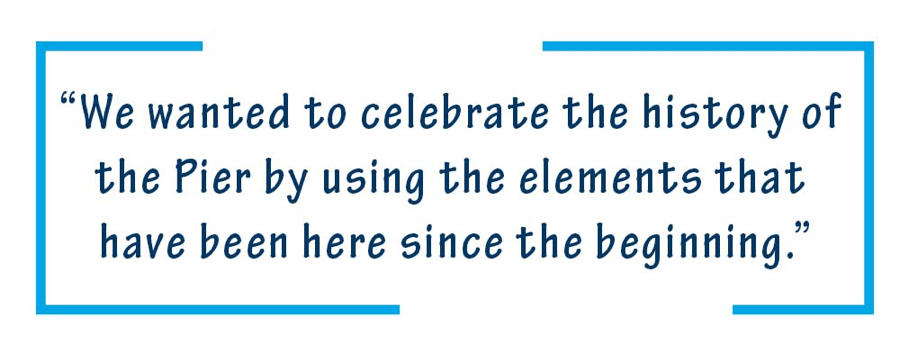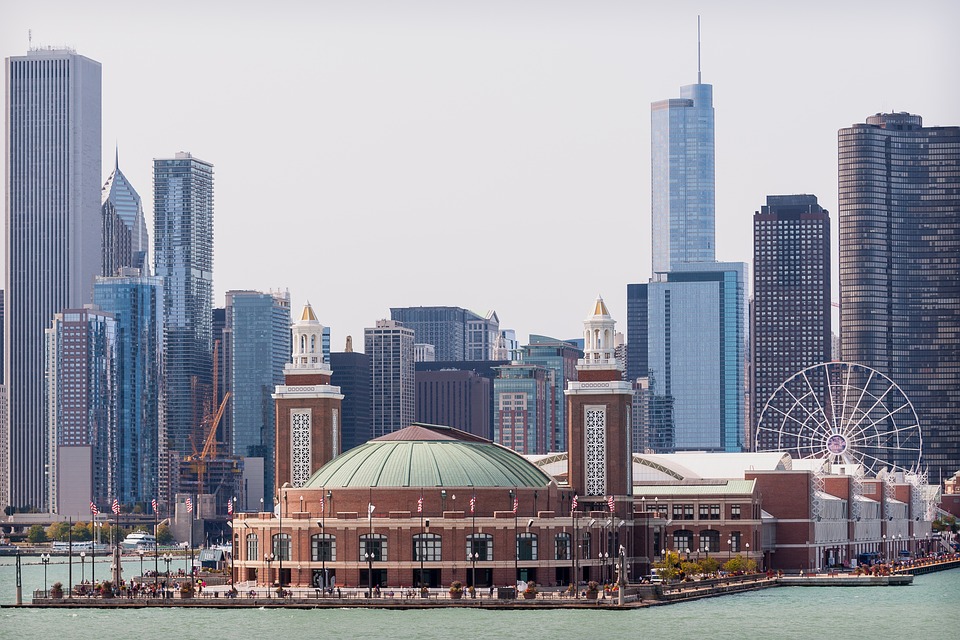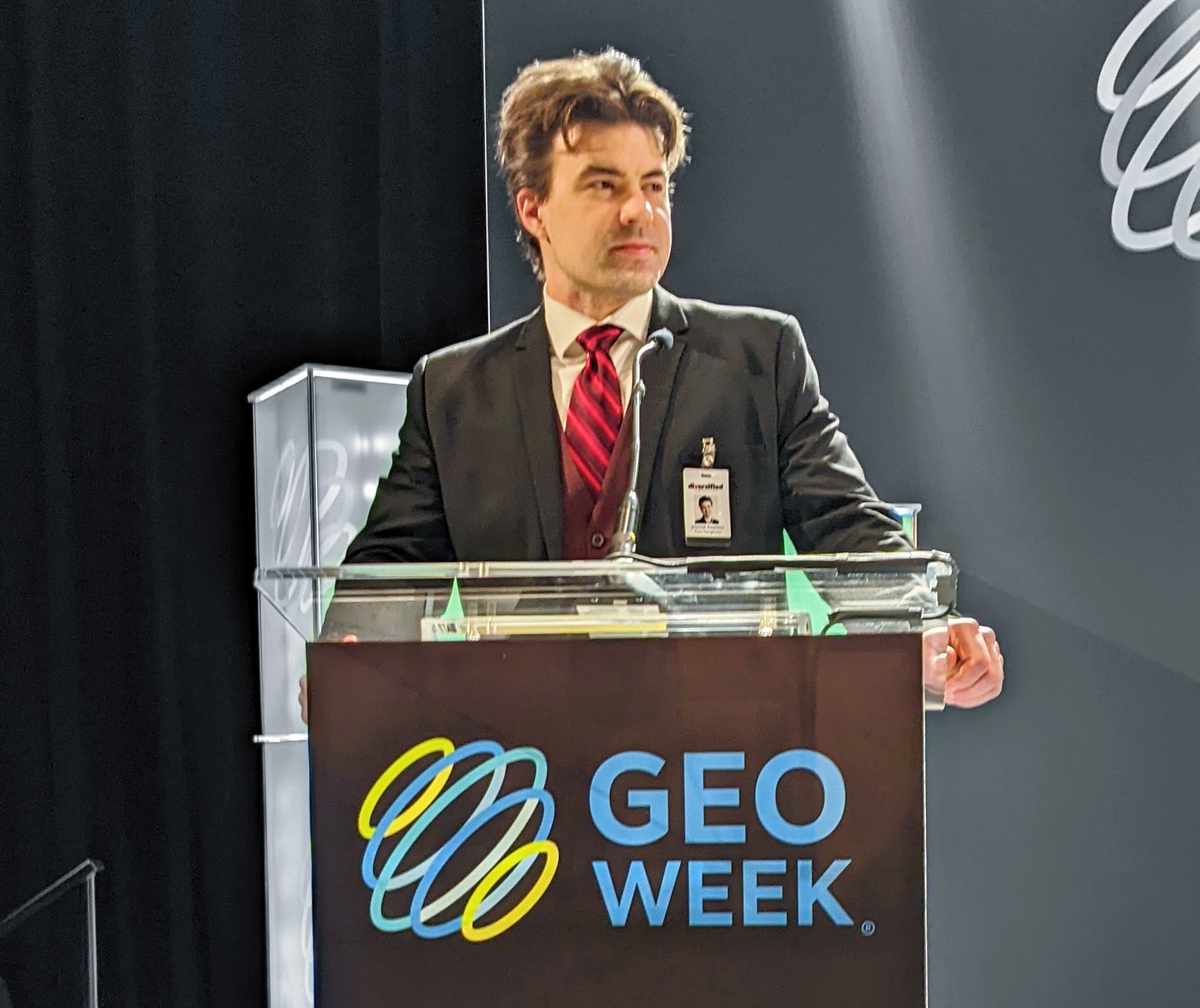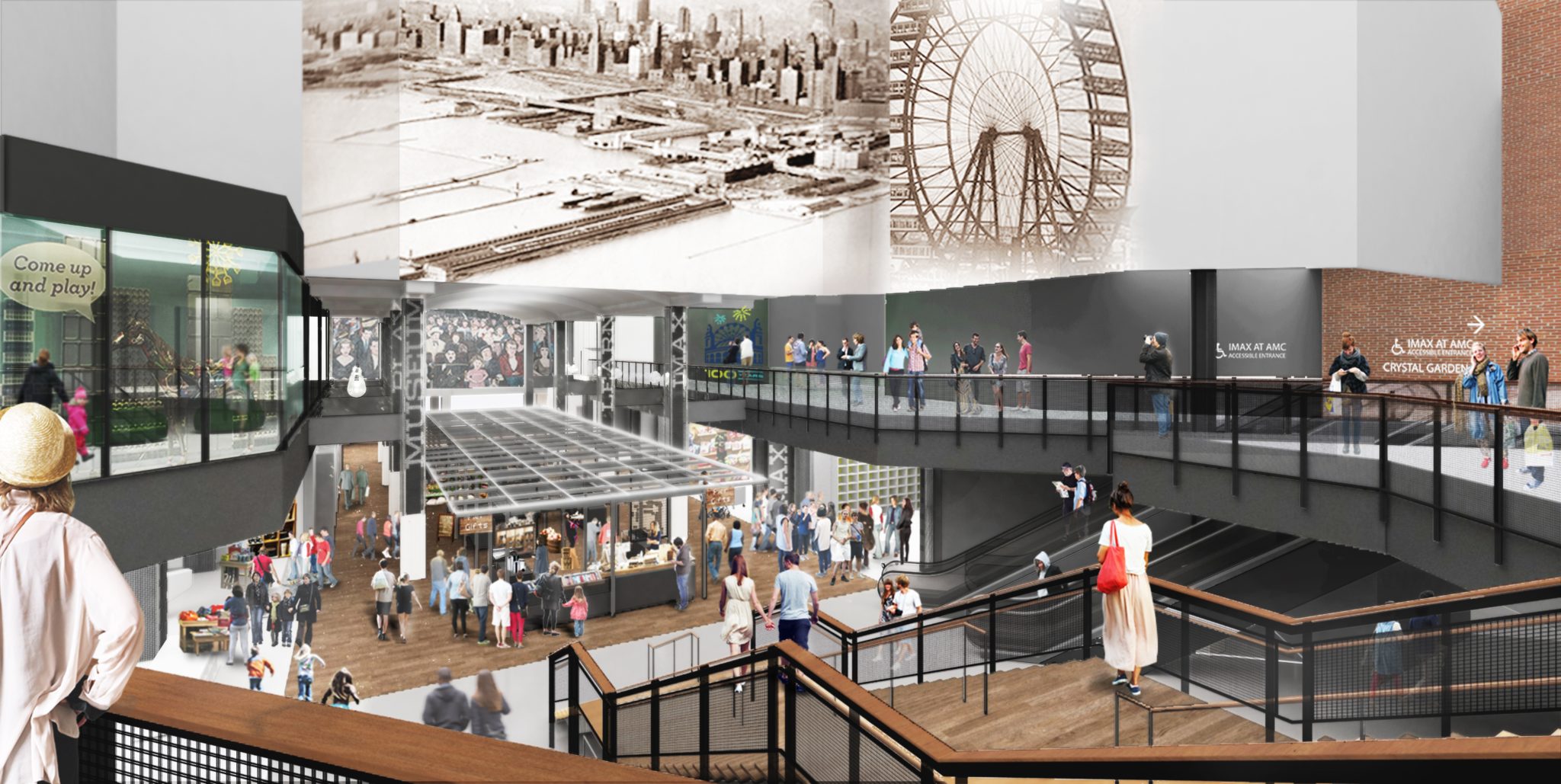Part of the “Transforming Spaces and Places in AEC” Series
Chicago, Illinois attracts millions of tourists every year, and Navy Pier is a top destination for many of these visitors. The 3,300-foot-long pier that sits on the shoreline of Lake Michigan features more than fifty acres of parks, gardens, shops, restaurants, exhibition facilities and an iconic Ferris wheel, meaning there’s something for everyone who visits the city.
However, at some point Navy Pier turned into a destination that seemed as if it were built for tourists, as opposed to the people who live and work in Chicago. What would it mean to see this space transition into something that residents of the area wanted to visit? How would Navy Pier have to evolve so that the people of Chicago would feel comfortable going anytime of year? Could the space serve both the local community and visitors from around the world?
These were just some of the considerations the Chicago office of Gensler took into consideration with the Centennial Vision, which is a framework for the re-imagination of Navy Pier in honor of its 100th anniversary. Gensler conceptualized and designed a master vision that would establish the Pier as a global destination and solidify its sustainability for generations to come. It has been an effort that has not only redefined Navy Pier, but has provided a powerful showcase around how design can impact experiences to enable powerful transformations for spaces and places.

As an attraction that pulls in more than 9 million guests a year, it’s clear that Navy Pier is popular in a way that few other places in the city and even the country can match. That fact might make it appear to be ill suited for a re-imagination, but many Navy Pier stakeholders realized that this popularity was built on something that might not last. This drove the creation of a comprehensive redevelopment plan that would see the space transformed into a “People’s Pier” for the 21st century.

Benjy Ward
Gensler Chicago Principal and Design Director Benjy Ward has led the efforts to see this transformation realized since the project began. His perspective around enabling this evolution is something that stems from his work in Gensler offices from San Francisco to Shanghai where he was involved with projects that showcased different uses and experiences for visitors of all types. Those insights were particularly relevant at Navy Pier, especially as some questioned why this effort was a necessary one in the first place.
“Seeing as how Navy Pier has always been such a success, one of the big questions that came up early in the process was, ‘why are you fixing what isn’t broken?’” Ward told AEC Next News. “There’s no doubt that the Pier had a ton of traffic, but the problem was that many locals thought of it as a tourist destination rather than as an amenity or civic center. So the idea was to bring it back so that people of Chicago could feel comfortable there. We certainly want those tourists to still view it as a destination, but making the space a real center for the community would allow us to ensure the Pier would be viable in the long-term.”
The focus on this kind of long-term viability on the part of Navy Pier stakeholders is a key element in this transition, because it’s something that can be as difficult as it is counterintuitive. It’s not easy to foresee that something doing well in the present might not be doing so in the future, but that recognition made this transformation a necessity, despite the challenges associated with doing so.
That said, one of the essential aspects of this evolution is that it’s not at the expense of the current audience. Understanding the current and future audience was a key consideration in all of these efforts, both in terms of how Navy Pier functioned in the present, and what needed to change to make it work in the future. Gensler has worked to ensure this current audience will still be able to see the Pier as a destination, even as their reasons for doing so will change.
“Navy Pier had become a place where tourists felt comfortable because they’ve seen it all before,” Ward continued. “It’s something that happens in a million other places which are designed to cater to this crowd, so you’ll see certain stores, certain chains, and certain products in all these places. It really didn’t seem like a Chicago experience, and I think what we’ve done is try and truly get back to something that feels more like what Navy Pier was supposed to be, which is a real amenity for the people of Chicago that visitors can enjoy and appreciate on a whole new level.”
Transitioning this space into a Chicago amenity didn’t mean excluding tourists or making them not feel welcome, but to instead invite them to the space in a different way. It meant using the history of the Pier and the identity of Chicago to bring in both residents and tourists. Doing so necessitated being able to look backward and forward simultaneously.

 Navy Pier has a history that stretches back to 1916, when it was first opened. Originally, it was designed as a space for indoor and outdoor recreation for the public. Many events were held at the Pier, and that includes expos, concerts and plenty other forms of entertainment. Over the years, various other elements were added to the Pier, some of which worked better than others. The master vision that Gensler looked to realize was about stripping away all these ancillary elements and taking Navy Pier back to something that could easily be celebrated.
Navy Pier has a history that stretches back to 1916, when it was first opened. Originally, it was designed as a space for indoor and outdoor recreation for the public. Many events were held at the Pier, and that includes expos, concerts and plenty other forms of entertainment. Over the years, various other elements were added to the Pier, some of which worked better than others. The master vision that Gensler looked to realize was about stripping away all these ancillary elements and taking Navy Pier back to something that could easily be celebrated.
“The first time we looked at the Pier, we decided we wanted to scrape it down to the structure,” Ward explained. “That meant literally getting down to the core of what’s here by doing things like exposing ceilings and columns. We wanted to celebrate the history of the Pier by using the elements that have been here since the beginning. We wanted to strip away what’s been added over the past few decades to get down to the essence of the Pier.”
That essence is ultimately about a collection of spaces that has at times contained everything from a gym to a kitchen to a barbershop. The push to embrace and celebrate this history can be seen in areas like the newly renovated Family Pavilion, which now houses several restaurants, retail shops and kiosks to enhance the guest experience. Guests now have that much more to see and do thanks to the improved features and new partnerships that are part of this re-imagined Family Pavilion.
Being able to utilize elements that have been part of Navy Pier since the beginning is also evident in Polk Brothers Park, which serves as the unofficial front lawn of the attraction. The project consists of two performance areas where visitors can sit and watch a show while looking out at the rest of Navy Pier and Lake Michigan. It’s a great example of a uniquely surreal Chicago experience that can only be had in this space, all of which goes back to the features that were evident when the park opened in 1916. These elements appealed to the residents of the time, and being able to do so again was very much priority.
“One of the things we said was that we wanted to make Navy Pier a place where we would want to go,” Ward continued. “Locals might make a yearly trip out to the Pier, but that was often the extent of it. That got us to ask whether or not there was a way to create something that felt like more like the center of the city that would be a community gathering point. It’s the goal we’ve been working toward, and I think we’re getting closer and closer to that.”
That sense of community can be seen in various areas of the re-imagined Navy Pier, and it’s one that appeals to both residents and tourists for different reasons. These elements are creating distinct experiences for visitors, which provides us with a great look at the broad impact design can have on experience.

 The concept of enabling and creating experiences is something that’s becoming more and more of a priority for AEC projects of all shapes and sizes, and was very much a central aspect of the Centennial Vision. Getting down to the essence of the Pier was a priority, but doing so to enable a uniquely Chicago experience was always the focus.
The concept of enabling and creating experiences is something that’s becoming more and more of a priority for AEC projects of all shapes and sizes, and was very much a central aspect of the Centennial Vision. Getting down to the essence of the Pier was a priority, but doing so to enable a uniquely Chicago experience was always the focus.
“The experience is everything we’re trying to deliver,” Ward emphasized. “Our focus was centered on the idea of creating a more consistent Navy Pier brand so that it didn’t feel like a bunch of disjointed pieces. Instead, we wanted the experience to feel like an agglomeration of really interesting spaces, so that each space could tell a unique story.”
Those stories could then be showcased in a way that augments the overall whole, all of which have been designed to feel more local and authentic. Whether it’s the Polk Bros Park Fountain and Plaza, a greener and more contemporary South Dock promenade, an authentic Chicago Food Experience or the new Centennial Wheel, all of these elements are designed to provide users with an experience that resonates on an individual level. Because of these distinct experiences, the whole story of the Navy Pier is very much greater than the sum of all of these parts for visitors, regardless of where they’re coming from.
Gensler has made a conscious effort to quantify the broad impact of design on experience, all of which is about inspiring the creation of places that engage people’s emotions. Their focus on being able to create experiences that are not just unique, but designed to work on multiple levels and keep people coming back, is something that’s notable in light of how technology has changed people’s behavior and expectations.
“What we’re seeing across the industry right now, especially in retail though, is that anyone who can’t offer what I’ll call ‘visceral interactions’ won’t make it,” Ward said. “Being able to provide something the Internet can’t is critical, and that means cultivating a more human experience that produces memories. It means creating places that are constantly reinventing themselves. Those are the only places that are going to survive, and it’s why we worked to make sure that human experience was the driving force behind every element at the Navy Pier.”
This focus on experience has seen stakeholders for a variety of projects push to design spaces that influence positive emotions and make every space feel like a public space. These kinds of efforts have redefined how audiences think of and interact with a given space in a profound way. The changes this has meant for Navy Pier are palpable, and they showcase what kind of power the focus on such things can enable anywhere and everywhere.

 The vision Navy Pier stakeholders had in terms of understanding where things were with the site in the present and how that would impact the future is a critical aspect of the transformation that has been enabled. It’s the sort of change that is necessary in a much more direct sense for countless other spaces and places, so what lessons can be drawn from this endeavor? How can these sorts of changes take place at locations that might not be as popular in the present?
The vision Navy Pier stakeholders had in terms of understanding where things were with the site in the present and how that would impact the future is a critical aspect of the transformation that has been enabled. It’s the sort of change that is necessary in a much more direct sense for countless other spaces and places, so what lessons can be drawn from this endeavor? How can these sorts of changes take place at locations that might not be as popular in the present?
“The best thing to do is to start by identifying the meaning and history of whatever it is you’re looking to see transformed,” Ward mentioned. “How did it start? What was the original intention? We asked those kinds of questions at Navy Pier in order to discover the authentic pieces that we’d be able to draw from. You’re in a much better position to see something resonate whenever you can tell the truth with it.”
Over time, certain areas of the Pier were transformed into malls, while retail that had little to do with the identity of the city popped up. Being able to go back to what worked for the attraction in the first place has been an important aspect of ensuring that the transformation as a whole would resonate.
Outside of this focus on authenticity, the ability to create and pursue a bold vision is also an important consideration. The fact that the Centennial Vision was pursued when millions of people were already coming to the site on an annual basis speaks to the boldness of that vision. The scope of change that was being pursued helped make it a reality.
“The Daniel Burhnam quote, ‘Make no little plans; they have no magic to stir men’s blood,’ is appropriate here,” Ward said. “Navy Pier was always meant to be a space for the people to really enjoy the lake, and we wanted to make it so what we did would be seen as a continuation of the visionary work he began over a century ago. Anyone looking to establish a similar vision should make sure they’re doing so in a big way. We had a big plan to make it so that Navy Pier would be something for the people of Chicago, and that’s the kind of goal that can capture people’s hearts and minds.”
Simply putting up a new building or structure can be a simple endeavor when compared to the kind of broad goals like the one that’s been realized at Chicago’s Navy Pier. These are the kinds of goals and ambitions that ultimately drive the transformation of space and places, which is evident in big and small ways on the re-imagined Navy Pier.
To find out the latest updates regarding Navy Pier’s redevelopment plans and efforts, visit www.navypier.com.







